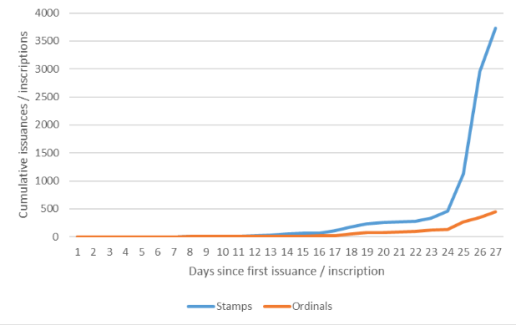In recent weeks, another development has taken the Bitcoin community by storm: Bitcoin Stamps.
Thanks to the recent surge in Ordinals, Bitcoin Stamps have emerged as the latest craze in Bitcoin digital collectibles. They have harnessed the security of the Bitcoin L1 to offer yet another avenue for users to explore the possibilities that exist on the Bitcoin blockchain.
The flexibility to mint or stamp digital collections on Bitcoin has seen activity grow more rapidly than Ordinals. We’ll explain how, and why.
What are Bitcoin Stamps?
Bitcoin Stamps are akin to ERC-1155 semi-fungible tokens or digital collectibles. However, they are stored directly on Bitcoin’s unspent transaction outputs (UTXOs) – which are records of unspent Bitcoin when transactions between two addresses are made – rather than in the witness data like Ordinals.
In order to understand how Bitcoin Stamps are minted, we also need to understand the Counterparty protocol.
What is the Counterparty Protocol?
Counterparty is an open-source messaging protocol developed in 2014 that is built on the Bitcoin blockchain. It has a native decentralized exchange (DEX) and token (XCP), allowing users to mint and trade digital assets. When the token launched in 2014, the token generation event utilized Proof-of-Burn (PoB). Users could send BTC to a burn address in exchange for XCP tokens to promote a fair and decentralized token allocation.
The protocol uses OP_Return and multisig transactions to store image data. The OP_Return function allows users to store a small amount of additional information (e.g., note, message, or reference number) up to 80 bytes of data. However, if the file is larger than 80 bytes, the protocol uses a ⅔ multi-sig to store data across multiple outputs. Counterparty software running on a Bitcoin node interprets this blockchain data and indexes the image.
Fun Fact: Counterparty minted some of the earliest non-fungible token (NFT) collections like Spells of Genesis, Rare Pepes, Bassmint, and Phockheads.
How does Counterparty Mint Bitcoin Stamps?
An image is converted to text and encoded as a Base64 file, appending “STAMP:” before the text. The encoded file is then broadcasted to the Bitcoin network using the Counterparty protocol, where the file is broken down and validated on the network. The protocol then recompiles the file data, bringing life back to the original image.

Counterparty uses the Pay to Script Hash (P2ASH) transaction type when minting Bitcoin Stamps. It lets users securely send BTC to a script-linked address like a multi-sig wallet. These transactions settle to the Bitcoin blockchain and can be parsed and indexed by Counterparty nodes. Unlike Bitcoin, Counterparty nodes do not communicate with each other. Their primary role is to connect to Bitcoin software and interpret blockchain data based on specific rules.
Like any transaction on Bitcoin, users who mint Bitcoin Stamps will incur fees. However, they will pay approximately ~4x more than an Ordinals inscription. Ordinals are limited to a single inscription, so assuming a user mints multiple Bitcoin Stamps at one time, the cost of stamping could experience economies of scale. The recommended image size for a Bitcoin Stamp is 24x24px with 8-bit color depth of a PNG, GIF, or similar.
Bitcoin Stamps and Ordinals Faceoff
The witness data discount does not apply to minting Bitcoin Stamps, considerably increasing the cost (~4x) compared to Ordinals inscriptions. However, Counterparty provides less user friction in minting a 1:1 or 1:100 at any given time. Despite having limited tooling and wallet support, the protocol has more feature-rich capabilities for on-chain Bitcoin protocols than Ordinals.
The degree of immutability between Bitcoin Stamps and Ordinals differs. Encoded image data for Bitcoin Stamps live in the transaction outputs on the Bitcoin blockchain, requiring Bitcoin nodes to download all the data to maintain the blockchain. However, Ordinal's image data lives in witness data, creating an environment where the image data can be pruned.

Regardless of these differences, Bitcoin Stamps have been growing at a faster rate than Ordinals, likely due to the flexibility of minting larger quantities.
The Controversy around Bitcoin Stamps
The controversy around Bitcoin Stamps touches on various areas, which includes discussions around immutability and bloating the UTXO set.
When comparing Bitcoin Stamps to Ordinals, there was heated debate about which was more or less prunable. It became clear that Bitcoin Stamps are less prunable because image data is stored in Bitcoin’s UTXOs instead of its witness data. The initial discussion around the UTXO set bloat largely revolved around the uncertainty of increasing hardware requirements (e.g., RAM) for users running a Bitcoin node.
This is in addition to various Bitcoin community members' overall disagreement about using block space for the purpose of digital artwork. There has been an ongoing debate around the size of blocks on the Bitcoin blockchain and how an increase in transactions settling on-chain would bog down the network, causing an increase in transaction fees. Some community members have proposed increasing the block size, but many argue that it would make the network more vulnerable and raise the cost to miners due to increased data storage requirements.
Keep Building on Bitcoin
The emergence of Bitcoin Stamps comes at a great time as Ordinals has showcased strong interest across the Bitcoin and broader NFT community. Whether builders use existing software or develop new applications, it's evident there has been strong traction related to digital artwork and collectibles on Bitcoin.
The enthusiasm around Bitcoin Stamps is yet another example of the Bitcoin blockchain’s capabilities. Builders will continue focusing on developing new tooling and bringing exciting solutions to improve the user experience in the community.
